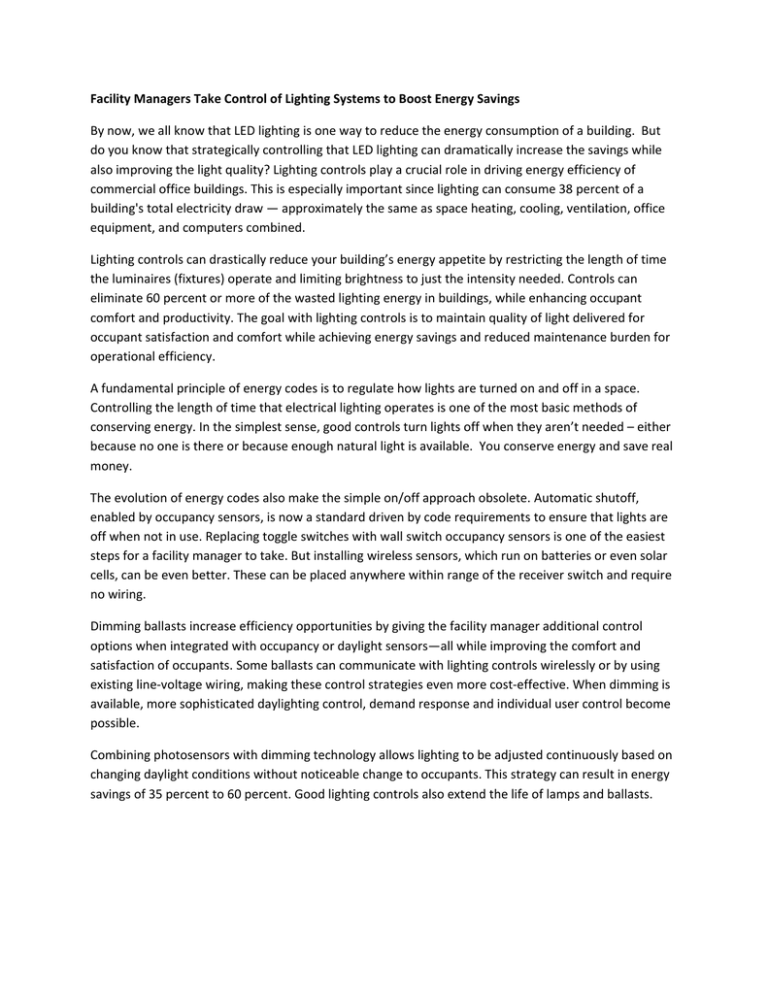
Facility Managers Take Control of Lighting Systems to Boost Energy Savings
By now, we all know that LED lighting is one way to reduce the energy consumption of a building. But
do you know that strategically controlling that LED lighting can dramatically increase the savings while
also improving the light quality? Lighting controls play a crucial role in driving energy efficiency of
commercial office buildings. This is especially important since lighting can consume 38 percent of a
building's total electricity draw — approximately the same as space heating, cooling, ventilation, office
equipment, and computers combined.
Lighting controls can drastically reduce your building’s energy appetite by restricting the length of time
the luminaires (fixtures) operate and limiting brightness to just the intensity needed. Controls can
eliminate 60 percent or more of the wasted lighting energy in buildings, while enhancing occupant
comfort and productivity. The goal with lighting controls is to maintain quality of light delivered for
occupant satisfaction and comfort while achieving energy savings and reduced maintenance burden for
operational efficiency.
A fundamental principle of energy codes is to regulate how lights are turned on and off in a space.
Controlling the length of time that electrical lighting operates is one of the most basic methods of
conserving energy. In the simplest sense, good controls turn lights off when they aren’t needed – either
because no one is there or because enough natural light is available. You conserve energy and save real
money.
The evolution of energy codes also make the simple on/off approach obsolete. Automatic shutoff,
enabled by occupancy sensors, is now a standard driven by code requirements to ensure that lights are
off when not in use. Replacing toggle switches with wall switch occupancy sensors is one of the easiest
steps for a facility manager to take. But installing wireless sensors, which run on batteries or even solar
cells, can be even better. These can be placed anywhere within range of the receiver switch and require
no wiring.
Dimming ballasts increase efficiency opportunities by giving the facility manager additional control
options when integrated with occupancy or daylight sensors—all while improving the comfort and
satisfaction of occupants. Some ballasts can communicate with lighting controls wirelessly or by using
existing line-voltage wiring, making these control strategies even more cost-effective. When dimming is
available, more sophisticated daylighting control, demand response and individual user control become
possible.
Combining photosensors with dimming technology allows lighting to be adjusted continuously based on
changing daylight conditions without noticeable change to occupants. This strategy can result in energy
savings of 35 percent to 60 percent. Good lighting controls also extend the life of lamps and ballasts.
Types of Lighting Controls
Optimizing energy efficiency isn’t as simple as replacing conventional lighting with LED fixtures. Greater
savings and better light quality depend upon the control you have over the lighting system. There is no
single “right way” to do it. Consider these options, based on the needs of your building occupants.
Scheduling: If your tenants have a predictable schedule, using a scheduling system to turn lights on and
off or to dim at specific times can be a simple, but effective, means of control. Augmented with
occupancy sensors for responsiveness in the case of people working off schedule, the system can help to
reduce energy usage. If scheduling is an option, astronomical time clocks are preferable because they
automatically adjust to sunrise and sunset events.
Sensors: Occupancy sensors that turn lights on or off when occupants enter or leave a space are best
suited for private office, utility closets, conference rooms, restrooms, and even stairwells. With LED
lighting, on/off cycles do not adversely affect lamp life and light quality, as is the case with fluorescent.
Tuning: This type of control allows a facility manager to set the appropriate light level for each space.
Some areas may require 40 footcandles of light on the work surface while others need only 20. Allowing
individual controls at workstations can help you save even more because many occupants prefer lower
light levels to minimize glare on computer screens. Programmable wall pod controls will allow you to
create distinct zones in a dynamic open office layout.
Gain Easier Control of Your Lighting System
Facility managers can maximize return on investment by focusing on the most effective control
strategies that also fit the operational tasks of the buildings they manage. These include automatic
switching and dimming, new wireless devices, systems using existing line-voltage wiring instead of lowvoltage wiring for control communication, and integrated approaches.
Advanced lighting control systems emerging in the market are smarter, easier to connect than
traditional wiring, offer self-commissioning, deliver usage reports and save more energy. These systems
leverage the benefits of digital control and plug-and-play cabling to deliver these gains. Savings from
lighting controls require little, if any, participation from building occupants once they are set to run,
removing one more task from a facility manager’s busy to-do list.
To receive future articles and papers like this, please click here to subscribe.
Content provided by Acuity Brands.
©2015 Acuity Brands Lighting, Inc. All rights reserved.




